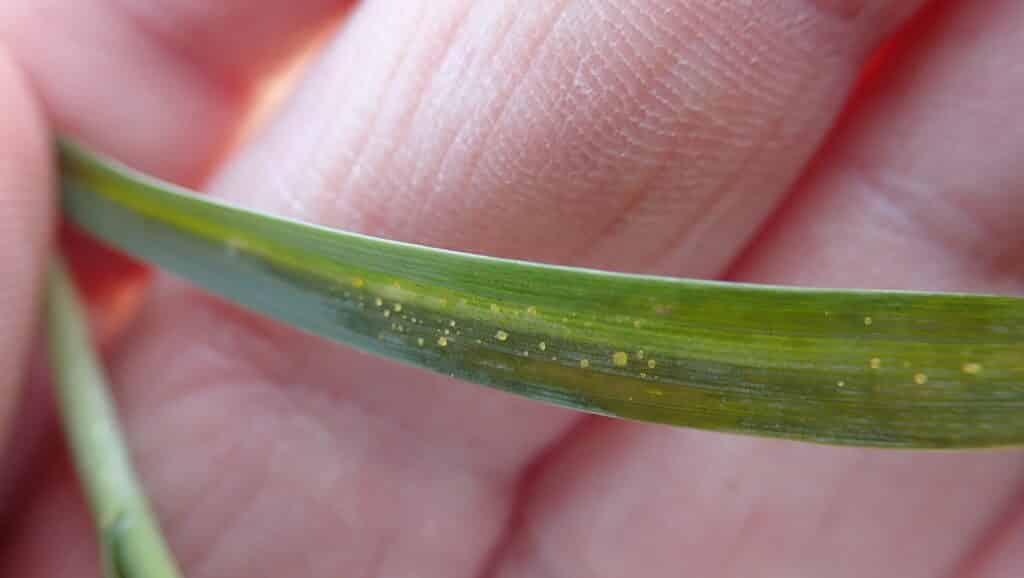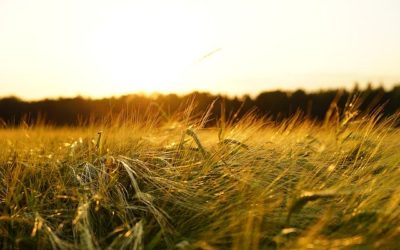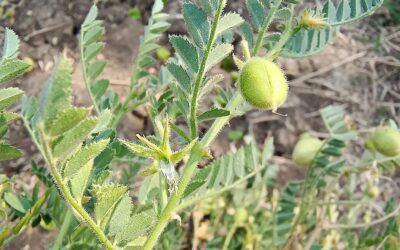With seed tests now available and awareness on the rise, bacterial leaf streak is a growing problem in Alberta.
Cereal crops in Alberta are hiding an emerging threat — bacterial leaf streak (BLS). While the bacterial disease has been around for decades, increasing awareness and seed tests are showing higher incidences of BLS in Alberta cereal fields.
“Up until about five years ago, it was really uncommon on the Canadian Prairies. We would see it from time to time, not at economic levels, but more of a curiosity. In the last five years, it’s become more common and more destructive,” Mike Harding, plant pathologist with Alberta Agriculture and Irrigation, says in a phone interview.
BLS is caused by a bacterium called Xanthomonas. There are different bacterial pathogens strains which can infect plants. Early stages of infection include necrosis on plants appearing as water-soaked lesions that look as if a leaf has been pressed on too hard between fingers with watery spots then appearing, Kim Kenward, research and development manager with 20/20 Seed Labs, explains during a Zoom interview. As the disease progresses, the lesions coalesce forming yellow and brown streaks.
“It’s a bacterial disease which affects the leaf tissue of the plant. So it destroys photosynthetic leaf area. And then it also moves up onto the head, resulting in head and grain infections. There could be an effect in terms of discolouration, which may affect grade and so on,” Kelly Turkington, a research scientist with Agriculture and Agri-Food Canada Lacombe, says in a phone interview.
BLS can impact a plant at all phases of its lifetime — the earlier it latches onto the plant the more impact it will have on yield. Yields can be reduced by as much as 50 per cent. The bacterium needs water to survive, meaning the more moisture it gets during its lifetime on the plant can worsen symptoms.
“If you get really heavy infections or high up into the plant, it affects filling of the kernels causing reduced kernel size. So in addition to yield loss, you’ll also get less healthy seed off of it because it just won’t have as much nutritional value to it,” Kenward explains.
It impacts cereal crops including wheat, barley, oats, triticale and rye. BLS is primarily a seed-borne disease. Infection happens when it’s warm and humid out, there’s a susceptible host and the pathogen is present. It spreads through oozing masses of bacterial cells splashing moisture droplets from infected plants onto non-infected plants, and from the lower to upper canopy. It can also be spread through infected seeds.
“It has to have a susceptible host that’s alive. And then it has to have enough moisture that the bacterium can grow and divide, and it has to be between about 15 degrees Celsius and 30 degrees Celsius. If all those conditions are met, it can get going,” Harding explains.

A barley seedling from late May, 2023 in central Alberta with droplets of bacterial ooze. Photo: Kelly Turkington
While bacteria leaf streak has been present in Alberta for a few decades, as of late there has started to be increased incidence of it in fields under irrigation. Frequent and heavy rainfall can also cause symptoms to pop up, but with drier conditions in Alberta during recent years BLS infections have mainly been discovered in irrigated cereal crops.
At 20/20 Seed Labs reports of the disease started as an increasing number of incidents of crop disease that weren’t responding to fungicide treatments. Kenward explains most diseases that growers expect in crops are associated with a fungus so to find a disease in field that’s not able to be treated by a fungicide can be a surprise.
The seed lab in recent years has started to offer a DNA test on seed to diagnosis BLS infections. During the 2023 growing season, 20/20 Seed Labs also started testing tissue samples also in order to do comparison tests and learn at what levels of infection the symptoms appear at.
“Our pathologist would have a really good hard look at suspect leaves to assess the amount of damage and check for evidence of bacteria under the microscope. We would then run the DNA test to measure how much Xanthomonas was present. There were a few instances when we detected bacteria but at low levels that weren’t sufficient to account for the level of damage seen on the tissue,” Kenward says.
While the disease is being studied, as of right now there isn’t much growers can do to manage BLS during the growing season. As it’s a bacterial and not fungal disease, fungicides don’t work to treat it. Turkington says research is showing the bacterium doesn’t survive in fields long term, so a two-year break from growing cereal crops could help reduce incidence in fields.

Kelly Turkington, a crop pathologist at Agriculture and Agri-food Canada’s Lacombe Research and Development Centre
“As we see more widespread development, more build up in individual fields, the residue aspect will become important especially in cereals especially under short rotations or continuous production,” Turkington adds. “However, even if you rotate to non-host (crops), volunteer cereals, if not managed effectively, can support infection and development.”
Farmers are also recommended to make sure they’re using a clean seed source not infected with BLS. Seed tests for infection can be done by 20/20 Seed Labs, SGS Biovision Canada and Discovery Seed Labs. If growing a crop under irrigation or if there are wet conditions during the growing season, farmers should scout their fields for any possible infections.
“Scouting is a good measure to give the farmer an idea of if a disease is present. It’s recommended to scout starting at the in-crop herbicide timing and all the way into when the leaf tissues start to naturally senescence,” Ruoxi Xia, agronomy extension specialist with Alberta Grains, says during a phone interview. “(Scout) especially after a major rain or thunderstorm events, because that’s when humidity is high, and the bacterium can be blown in by the storm.”
Harding adds that they’re seeing BLS in more fields each year at levels that can cause economic impacts on crops. During the 2023 growing season it was discovered in new fields which hadn’t had infections in the past.
“It’s not like an epidemic that’s widespread across the province, it’s still relatively isolated. But we’re not seeing the spread and the number of fields, and the number of producers affected, we’re not seeing that really slow down,” he adds. “It’s definitely something that cereal producers across the Canadian Prairies should be aware of and be scouting for.”
Header photo — Bacterial leaf streak infected barley, it has symptoms of streaking and droplets of bacterial ooze. Photo: Kelly Turkington
Related Articles
Stay Vigilant in Continued Fight Against Fusarium
The First Cut the Deepest for Alberta Winter Wheat Agronomy Research
Trait Stacking Opens Up World of Possibilities for Plant Breeding






